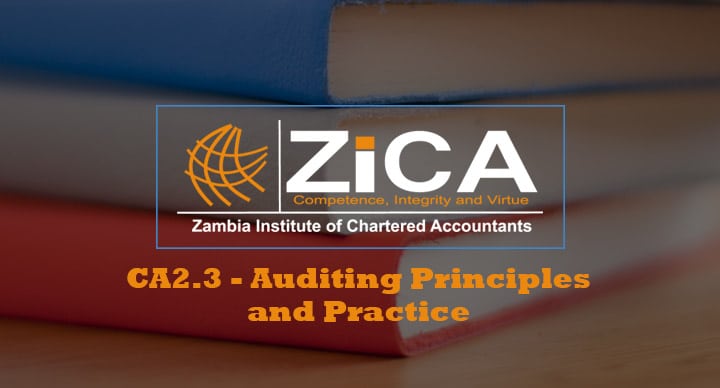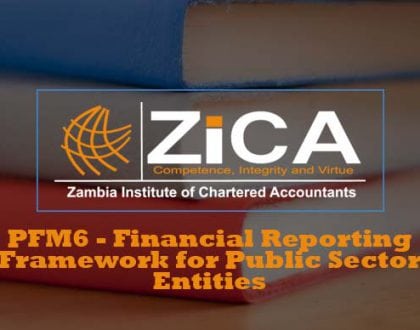CA2.3 – Auditing Principles and Practice
No access plans exist.

Course Features
Course Details
CA2.3-Auditing Principles and Practice
On completion of this module, candidates will reach a competency sufficient to be able to:- Explain the purpose of audit and assurance and the regulatory and professional requirements and practices involved in accepting and undertaking auditing or assurance engagements
- Explain and work with governance structures and ethical frameworks within organisations
- Evaluate what is needed to plan for, execute, and to report on auditing and assurance engagements
| Syllabus topics | Weighting (%) | LO |
| Purpose, regulatory and professional requirements of auditing or assurance engagements | 20 | 1, 2 and 3 |
| Governance and control structures, and ethical frameworks within organisations | 20 | 4, 5, 6 and 7 |
| Planning auditing and assurance engagements | 20 | 8 and 9 |
| Applying the techniques of auditing and assurance engagements | 20 | 10, 11 and 12 |
| Reporting on auditing and assurance engagements | 20 | 13 |
- LO1: Explain key audit and assurance concepts and the role of audit and assurance in relation to organisations
- DLO2: Explain audit and assurance regulatory requirements
- LO3: Explain the nature of levels of assurance and the key processes involved
- LO4: Explain the nature of governance and governance structures that support effective control environments
- LO5: Explain how governance is supported by effective control structures
- LO6: Explain the business, reporting and compliance objectives supported by internal controls
- LO7: Explain what is meant by professional ethics and how they can help resolve ethical dilemmas
- LO8: Explain the key components of effectively planned audit and assurance engagements
- LO9; Evaluate internal controls
- LO10: Evaluate the quality of audit evidence
- LO11: Apply appropriate procedures to gather evidence
- LO12: Evaluate the results of evidence
- LO13: Report appropriately on audit and assurance assignments
- Purpose, regulatory and professional requirements of auditing or assurance engagements: LO1, 2, 3
- Explain the concepts of audit and assurance
- Explain the reasons for and the benefits gained from the different types of audit and assurance assignments including those relating to financial statements, internal controls, corporate social responsibility, forensic audit engagements, and sustainability reports
- Explain using suitable comparisons the different levels of assurance that may be obtained from assignments
- Explain the meaning of public interest and the need for professional scepticism in carrying out assurance engagements
- Explain the meaning of reasonable assurance
- Explain the meaning of an opinion and an assurance report
- Explain audit and assurance regulatory requirements
- Explain the basic steps or components of an audit and assurance process, including:
- The approach, obtaining assignments and nomination
- Accepting an engagement
- Appointment
- Scope of work
- Risk and risk assessment
- Different approaches
- Planning
- Performance
- Concluding and considering an appropriate report
- Reporting
- Records and working papers
- Governance and control structures, and ethical frameworks within organisations: LO4, 5, 6, 7
- Explain the role and responsibilities of an effective board and management structure within an organisation and the responsibility relationship to stakeholders
- Explain the framework of accountability of management to a board
- Explain issues that challenge good governance structures, including:
- Transparency
- Separation of authority
- Lack of experience
- Under-developed governance practices in new and/or small organisations
- Explain the importance of probity as a principle of governance assessing issues and their implications
- Explain the nature of internal financial controls and internal controls
- Explain the meaning of effective internal financial controls and internal controls
- Explain what is meant by professional ethics and how they can help resolve ethical dilemmas, including:
- Explain the importance of professional ethics
- Explain the differences between rules based and principles based approaches to professional ethics
- Explain in context the meaning of public interest
- Explain ethical issues based on the IFAC code
- Select suitable actions to deal with ethical dilemmas
- Explain in context the fundamental ethical principles
- Explain in context the ethical threats and safeguards
- Explain in context ethical conflicts as an employee and as a practising accountant
- Planning auditing and assurance engagements: LO8, 9
- Plan audit and assurance engagements, applying professional scepticism, and paying attention to:
- Audit risk
- Risk assessment
- Materiality
- Levels of reasonable assurance
- The characteristics of fraud and error and the distinction between them
- Explain the business, reporting and compliance objectives supported by internal controls
- Explain the different types of internal control with emphasis on internal financial controls
- Explain the main components of internal control including, the control environment, risk assessment, control activities, information and communication and monitoring activities
- Explain how accounting systems and related internal controls may be identified, recorded and evaluated, paying attention to:
- IT general controls in a business, including controls over networks; software acquisition, development, change and maintenance; access security; physical security of assets; authorisation for access; segregation of the system personnel duties.
- Key IT application controls in a business, including completeness, validity, identification, authentication, authorisation, input controls
- Explain the limitations of internal controls
- Evaluate internal controls in a scenario stating how the controls support particular aspects of reliable financial reporting and support the prevention and detection of fraud and error
- Evaluate internal control weaknesses in a given scenario explaining how these may be rectified
- Plan audit and assurance engagements, applying professional scepticism, and paying attention to:
- Applying the techniques of auditing and assurance engagements: LO10, 11, 12
- Evaluate the quality of audit evidence, paying attention to:
- Obtaining evidence
- Testing and other work
- Using the work of internal audit
- Explain the different sources and quality of evidence and the methods of obtaining evidence including documenting and assessing systems and controls, tests of controls, substantive tests and analytical procedures
- Explain appropriate procedures to gather evidence including all of the above sources and procedures based upon a given scenario, paying attention to:
- Accounting estimates
- Auditing sampling
- Audit areas relating to: 1. Tangible non-current assets 2. Inventory 3. Receivables 4. Cash and bank 5. Liabilities and capital
- Evaluate results, paying attention to:
- Subsequent events
- Going concern
- Written representations
- Overall evaluation
- Evaluate the quality of audit evidence, paying attention to:
- Reporting on auditing and assurance engagements: LO13
- Evaluate based on a given scenario including information regarding evidence obtained whether that evidence is sufficient to provide an appropriate basis for a given opinion or report
- Identify the circumstances where written representations may be required stating how reliable such evidence may be
- Evaluate the circumstances where matters need to be raised with a senior assurance team member and how this should be communicated and documented
- Report appropriately on audit and assurance assignments Technical knowledge requirements – International Standards on Auditing The technical appendix details the depth of treatment of required technical knowledge and the progression of competence over the levels in the qualification.
This course does not have any sections.






i love the course